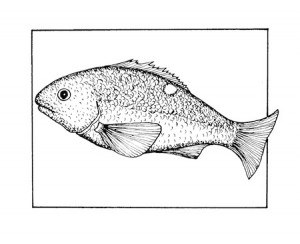By Mia Davidson and Jan Sattler
 Since January 2012, fishing in much of Laguna Beach is prohibited by law. Prior to that, one fish popular with anglers was the opaleye (Girella nigricans). The fish has dark olive-green backs and light undersides. Opaleye can be easily distinguished from other fish because they usually have two white spots on their upper back and bright blue-green opalescent eyes. Native to California and Baja Mexico, the non-migratory fish can reach a maximum of 11 years of age. Predators include sea lions, cormorants, terns and raptors such as eagles and ospreys.
Since January 2012, fishing in much of Laguna Beach is prohibited by law. Prior to that, one fish popular with anglers was the opaleye (Girella nigricans). The fish has dark olive-green backs and light undersides. Opaleye can be easily distinguished from other fish because they usually have two white spots on their upper back and bright blue-green opalescent eyes. Native to California and Baja Mexico, the non-migratory fish can reach a maximum of 11 years of age. Predators include sea lions, cormorants, terns and raptors such as eagles and ospreys.
Opaleyes make distinct changes as they move through their life stages both in habitat and in feeding. Spawning takes place in shallow water in late spring or early summer and eggs are discharged into the open ocean. As larvae, they live up to 75 miles offshore. When they are about an inch in size, the juveniles move to the warmer waters of the tidepools where they feed primarily on invertebrates. As they grow larger, they move to deeper tidepools until they reach approximately eight inches in length (about two years) then move to the open water of the sub tidal reefs and kelp beds. Forming schools, Opaleyes can ultimately grow to a maximum length of 25 inches. Adult opaleyes are omnivores with much of their diet consisting of algae and seagrass along with a small amount of crustaceans and hydroids.
Laguna Ocean Foundation’s tidepool educators can point out tidepools below Heisler Park, the Montage at Treasure Island and South Crescent Bay where juvenile opaleye can be seen. Adult opaleye are easily observed while snorkeling offshore near the reefs and kelpbeds. Being a shy fish that dart away when frightened, viewing is best done by sneaking up on them with the sun in front of you whether in the tidepools or in the ocean.
Laguna Beach residents Mia Davidson and Jan Sattler are year-round ocean swimmers and board members of Laguna Ocean Foundation, which fosters environmentally responsible stewardship of the local near shore habitats. For more information, please go to www.lagunaoceanfoundation.org




